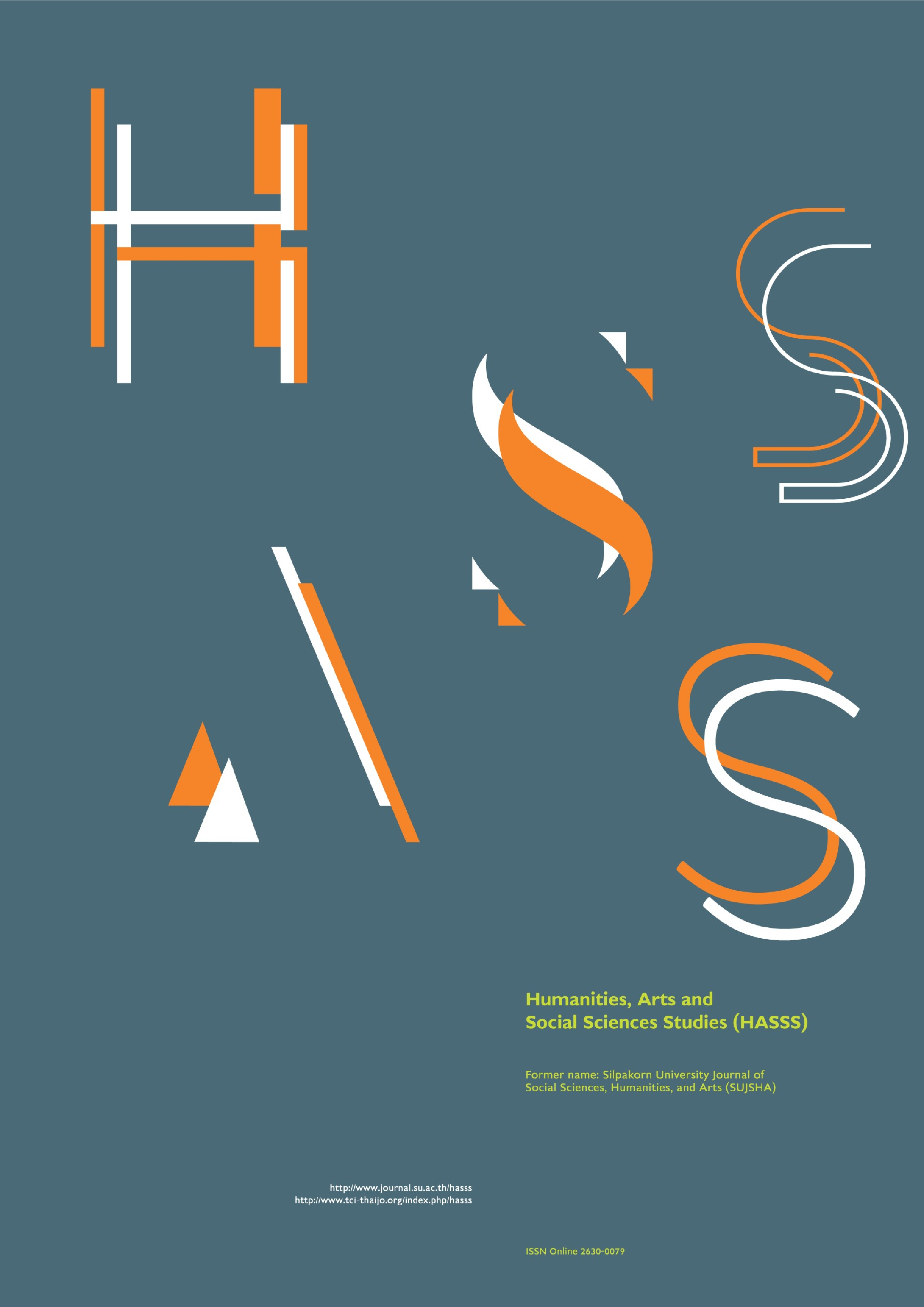Cultural capital for the development and conservation of ancient cities in western Thailand: A case study of the Ratchaburi and Phetchaburi provinces
Main Article Content
Abstract
This article studies the cultural capital of the ancient cities in Ratchaburi and Phetchaburi in the western part of Thailand to develop and conserve these ancient cities in a creative and sustainable manner. The analysis of literary evidence, together with historical, archaeological, artistic, and anthropological fieldwork surveys, was used in this research. The data collected were described with Pierre Bourdieu’s concept of cultural capital. The body of knowledge, which comprised the culture, art, and local wisdom of Ratchaburi and Phetchaburi, is a prominent cultural capital that can be employed to develop and conserve these ancient cities. This is because the long-time development of their history and their settlements was in accordance with their geographical locations; these two areas have been a hub, linking the cities in the Chao Phraya basin and those in the south. Moreover, the relationship between insiders and outsiders had an impact on the connection between the people, culture, and economy of the two places, which led to the exchange of resources, knowledge, wisdom, and beliefs. These events contributed significantly to the uniqueness of Ratchaburi and Phetchaburi, which can be exploited to develop both areas in various ways, especially sustainable cultural tourism. Thus, the development and conservation of these ancient cities requires the understanding of this cultural capital, which is the foundation of their economies and societies.
Downloads
Article Details

This work is licensed under a Creative Commons Attribution-NonCommercial-NoDerivatives 4.0 International License.
All rights reserved. Apart from citations for the purposes of research, private study, or criticism and review,no part of this publication may be reproduced, stored or transmitted in any other form without prior written permission by the publisher.
References
Bourdieu, P. (1977). Outline of a theory of practice (Cambridge studies in social and cultural anthropology) (R. Nice, Trans.). Cambridge University Press.
Burutphat, S., Deepadung, S., Suraratdecha, S., Ardsmiti, N., Patpong, P., & Setaponf, P. (2011). Ethno-linguistic maps of the western region of Thailand. Journal of Language and Culture, 30(2), 83–114. [in Thai]
Chanthawanit, S., Zhang, Y., Burutrattanaphan, W., M. R., Lertphanichkul, S., Duan, L., Tia-rakkijsakul, P., Xu, S., Luo, X., Deng, S., & Lin, F. (1991). Chaochin taechio nai prathet thai lae nai phumlamnaodoem thi chao-san (sa-mai thi nueng tha ruea changlin (2310–2393) [The Teochew People in Thailand and in Their Hometown, Shaoshan (The First Period: Zhanglin Port [1767–1850])]. Institute of Asian Studies, Chulalongkorn University. [in Thai]
Chumchit, Y. (2004) Prawatsat Mueang Ratchaburi [History of Ratchaburi City]. Odeon Store. [in Thai]
Fine Arts Department Thailand. (1966). Rai-ngan kansamruat lae khudtaeng boransathan boriwen Sa Kosinarai Amphoe Ban Pong Changwat Ratchaburi Phra Phothisat Ploengrasmi lae sila charuek Prasat Phrakhan khong Phrachao Chaiworaman Thi Ched [Report on the Survey and Excavation of the Archaeological Monuments around Kosinarai Pond in Ban Pong District, Ratchaburi Province and the Radiant Avalokitesvara and the Stele Inscription of Preah Khan of King Jayavarman 7th]. Fine Arts Department Thailand. [in Thai]
Fine Arts Department Thailand. (1989). Uthayan prawatsat Phra Nakhonkhiri [Phra Nakhon Khiri Historical Park]. Fine Arts Department Thailand. [in Thai]
Fine Arts Department. (2001). Phiphitthaphan sathan haeng chat Ratchaburi lae Changwat Ratchaburi [Ratchaburi National Museum and Ratchaburi Province]. Samanphan Press. [in Thai]
Kaeothep, K., & Hinwiman, S. (2008). Saithan haeng nakkhit thritsadi sethasat kanmueang kab suesansuksa [Prominent theorists in political economy and communication studies] (2nd ed.). Parbpim. [in Thai]
Kanjanajuntorn, P. (2013). Rai-ngan wichai kansamruat wattanatham boran bon Lumnam Mae Klong – Tha Chin nai chuang phutthasatawat thi 16–18 duay theknoloyi sue raya klai (Remote sensing) [Research Report on the Survey of the Ancient Culture on the Mae Klong–Tha Chin River Basins During the 21st–23rd Centuries Applying Remote Sensing Technology]. Geo-Informatics and Space Technology Development Agency (GISTDA). [in Thai]
Leksukhum, S. (1999). Sinlapa Atutthaya: Ngan changluang haeng paendin [Ayutthaya art: Royal art of the kingdom]. Muang Boran. [in Thai]
Phibunsombat, B. (2000). Wat Ko Tambon Tharab Changwat Phetchaburi [Wat Ko in Tha Rap Sub-district, Phetchaburi Province]. Phet Phum Printing. [in Thai]
Rakkiattiyod, K. (2019). The Thai-Chinese Community in Phetchaburi Province. Journal of Human and Society, Sisaket Rajabhat University, 3(2), 114–129. https://so08.tci-thaijo.org/index.php/jhuso/article/view/579 [in Thai]
Sukhasavasti, S., M.R. (2000). Kamphucharachalaksami thueng sichayaworaman [Kambujarajalaksmi to Srijayavarman]. Matichon. [in Thai]
Suwannachang, N. (2015). Ban chin wat ko lo thang saikao boklao khwamlang [Ban Chin & Wat Ko: Taking the old route narrating the old days]. Faculty of Humanities and Social Sciences, Phetchaburi Rajabhat University. [in Thai]
Talalak, N. (2019). Development and knowledge management of stucco art in Phetchaburi: Mr. Thongruang Em-ot, national artist in visual art (miiorart-stuccoart) [Unpublished doctoral dissertation]. Burapha University. [in Thai]
Talaluck, P., Chinnasi, O., & Thongpunya, T. (2019). Social capital and inheritance of local wisdom Phetchaburi’s art and craft of Look Wa group at Phetchaburi province. Journal of Social Development and Management Strategy, 21(2), 28–44. [in Thai]
U-luchada, P. (2001). Na-ban: Ekkalak sinlapa sathapattayakamthai [Gables: The identity of Thai art and architecture] (2nd ed.). Muang Boran. [in Thai]
Wanliphodom, S. (2009). Ruan thai ban thai [Traditional Thai houses and Thai houses] (3rd ed.). Muang Boran. [in Thai]
Wilaikaeo, C. (1991). Wat Kamphaenglaeng. Muang Boran Journal, 17(4), 104–110. [in Thai]
Wongthet, P. (Ed.) (1993). Lumnam mae klong: Phatthanakan thang sangkhom lae wattanatham [The Mae Klong Basin: Socio-Cultural development]. Silpakorn University. [in Thai]


